The Developing Manager: Principles, Skills, and Career Development
VerifiedAdded on 2019/12/28
|19
|6103
|490
Report
AI Summary
This report delves into the multifaceted aspects of management, encompassing principles, practices, and self-evaluation. It begins by comparing various management styles such as autocratic, democratic, laissez-faire, and paternalistic, using examples like Manchester City and Manchester United to illustrate their practical application. The report then explores leadership characteristics like honesty, consistency, and communication skills. Furthermore, it analyzes organizational culture and its impact on change management. A significant portion of the report is dedicated to self-assessment, including SWOT analysis and the identification of self-management skills. The report concludes with a discussion on managerial skills in a business context and the creation of career development plans, emphasizing the relationship between personal and management skills. The report references various academic sources to support its claims.
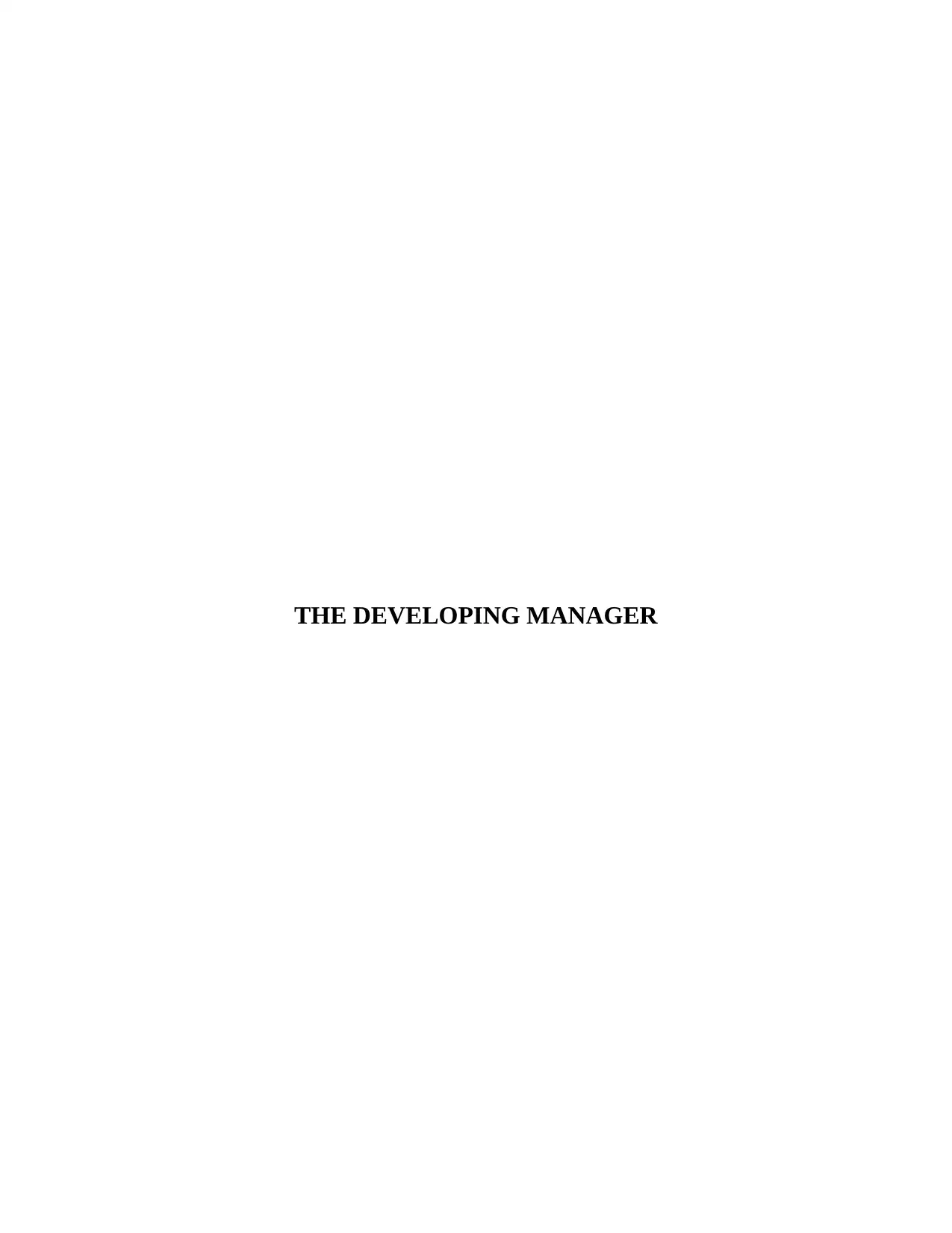
THE DEVELOPING MANAGER
Paraphrase This Document
Need a fresh take? Get an instant paraphrase of this document with our AI Paraphraser
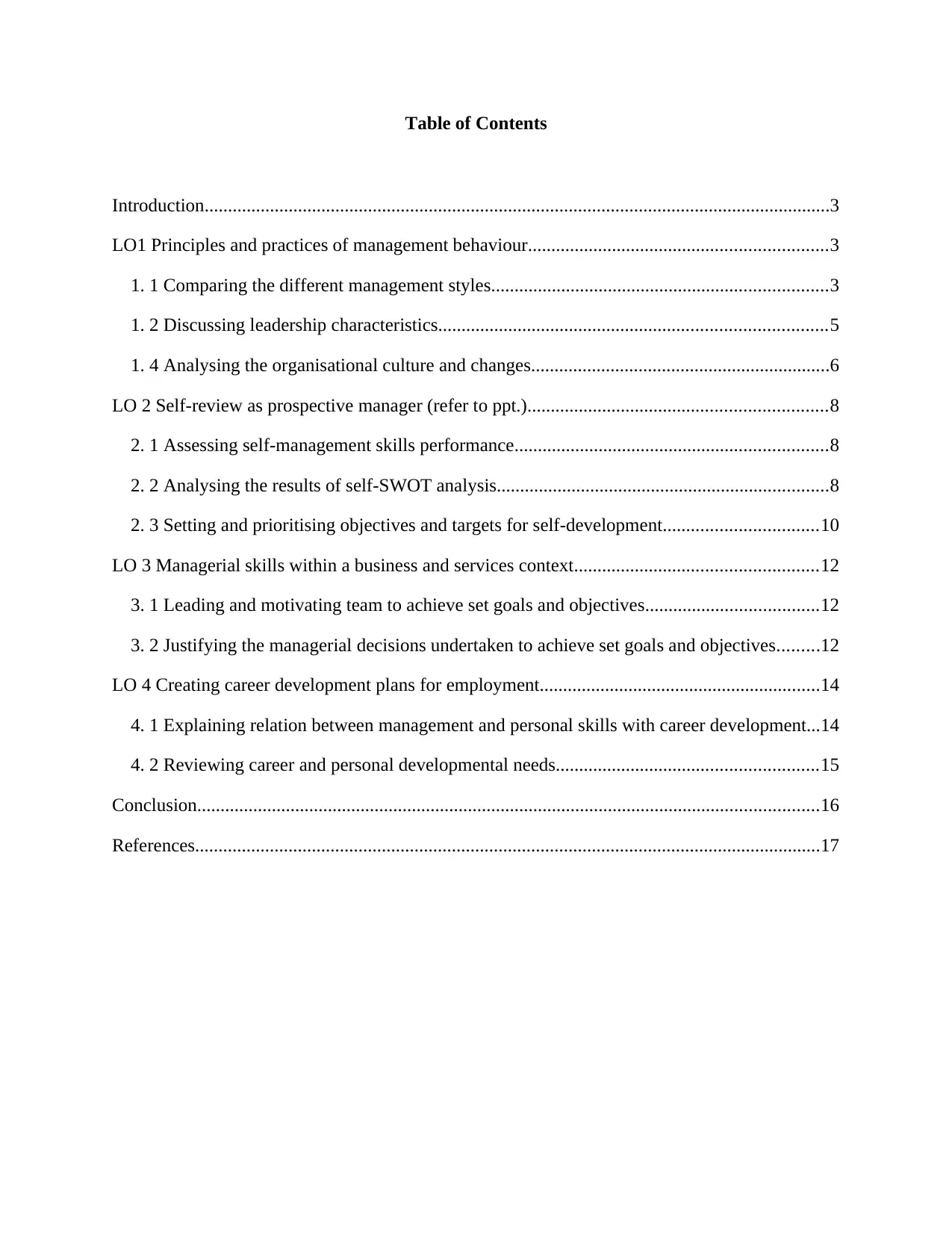
Table of Contents
Introduction......................................................................................................................................3
LO1 Principles and practices of management behaviour................................................................3
1. 1 Comparing the different management styles........................................................................3
1. 2 Discussing leadership characteristics...................................................................................5
1. 4 Analysing the organisational culture and changes................................................................6
LO 2 Self-review as prospective manager (refer to ppt.)................................................................8
2. 1 Assessing self-management skills performance...................................................................8
2. 2 Analysing the results of self-SWOT analysis.......................................................................8
2. 3 Setting and prioritising objectives and targets for self-development.................................10
LO 3 Managerial skills within a business and services context....................................................12
3. 1 Leading and motivating team to achieve set goals and objectives.....................................12
3. 2 Justifying the managerial decisions undertaken to achieve set goals and objectives.........12
LO 4 Creating career development plans for employment............................................................14
4. 1 Explaining relation between management and personal skills with career development...14
4. 2 Reviewing career and personal developmental needs........................................................15
Conclusion.....................................................................................................................................16
References......................................................................................................................................17
Introduction......................................................................................................................................3
LO1 Principles and practices of management behaviour................................................................3
1. 1 Comparing the different management styles........................................................................3
1. 2 Discussing leadership characteristics...................................................................................5
1. 4 Analysing the organisational culture and changes................................................................6
LO 2 Self-review as prospective manager (refer to ppt.)................................................................8
2. 1 Assessing self-management skills performance...................................................................8
2. 2 Analysing the results of self-SWOT analysis.......................................................................8
2. 3 Setting and prioritising objectives and targets for self-development.................................10
LO 3 Managerial skills within a business and services context....................................................12
3. 1 Leading and motivating team to achieve set goals and objectives.....................................12
3. 2 Justifying the managerial decisions undertaken to achieve set goals and objectives.........12
LO 4 Creating career development plans for employment............................................................14
4. 1 Explaining relation between management and personal skills with career development...14
4. 2 Reviewing career and personal developmental needs........................................................15
Conclusion.....................................................................................................................................16
References......................................................................................................................................17
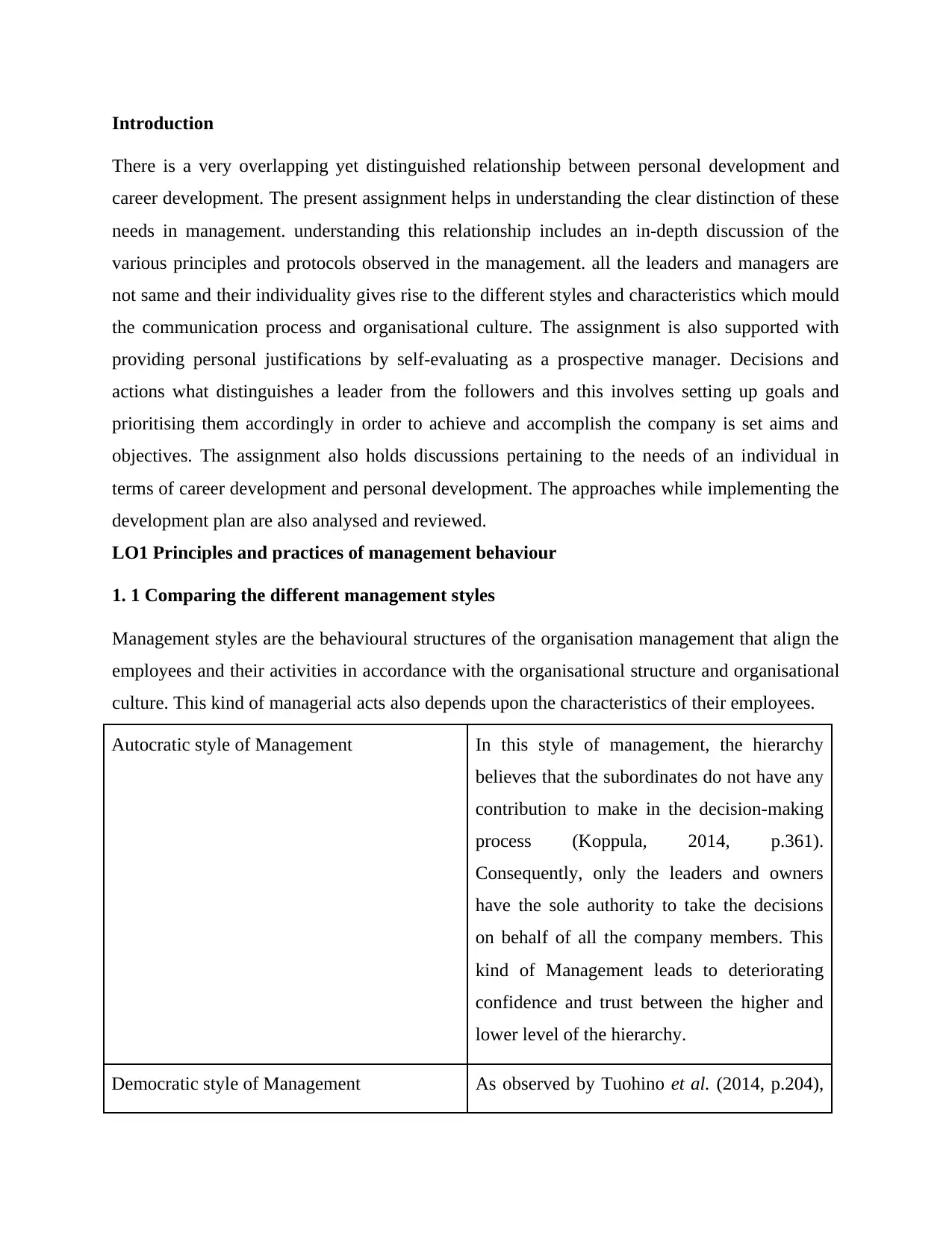
Introduction
There is a very overlapping yet distinguished relationship between personal development and
career development. The present assignment helps in understanding the clear distinction of these
needs in management. understanding this relationship includes an in-depth discussion of the
various principles and protocols observed in the management. all the leaders and managers are
not same and their individuality gives rise to the different styles and characteristics which mould
the communication process and organisational culture. The assignment is also supported with
providing personal justifications by self-evaluating as a prospective manager. Decisions and
actions what distinguishes a leader from the followers and this involves setting up goals and
prioritising them accordingly in order to achieve and accomplish the company is set aims and
objectives. The assignment also holds discussions pertaining to the needs of an individual in
terms of career development and personal development. The approaches while implementing the
development plan are also analysed and reviewed.
LO1 Principles and practices of management behaviour
1. 1 Comparing the different management styles
Management styles are the behavioural structures of the organisation management that align the
employees and their activities in accordance with the organisational structure and organisational
culture. This kind of managerial acts also depends upon the characteristics of their employees.
Autocratic style of Management In this style of management, the hierarchy
believes that the subordinates do not have any
contribution to make in the decision-making
process (Koppula, 2014, p.361).
Consequently, only the leaders and owners
have the sole authority to take the decisions
on behalf of all the company members. This
kind of Management leads to deteriorating
confidence and trust between the higher and
lower level of the hierarchy.
Democratic style of Management As observed by Tuohino et al. (2014, p.204),
There is a very overlapping yet distinguished relationship between personal development and
career development. The present assignment helps in understanding the clear distinction of these
needs in management. understanding this relationship includes an in-depth discussion of the
various principles and protocols observed in the management. all the leaders and managers are
not same and their individuality gives rise to the different styles and characteristics which mould
the communication process and organisational culture. The assignment is also supported with
providing personal justifications by self-evaluating as a prospective manager. Decisions and
actions what distinguishes a leader from the followers and this involves setting up goals and
prioritising them accordingly in order to achieve and accomplish the company is set aims and
objectives. The assignment also holds discussions pertaining to the needs of an individual in
terms of career development and personal development. The approaches while implementing the
development plan are also analysed and reviewed.
LO1 Principles and practices of management behaviour
1. 1 Comparing the different management styles
Management styles are the behavioural structures of the organisation management that align the
employees and their activities in accordance with the organisational structure and organisational
culture. This kind of managerial acts also depends upon the characteristics of their employees.
Autocratic style of Management In this style of management, the hierarchy
believes that the subordinates do not have any
contribution to make in the decision-making
process (Koppula, 2014, p.361).
Consequently, only the leaders and owners
have the sole authority to take the decisions
on behalf of all the company members. This
kind of Management leads to deteriorating
confidence and trust between the higher and
lower level of the hierarchy.
Democratic style of Management As observed by Tuohino et al. (2014, p.204),
⊘ This is a preview!⊘
Do you want full access?
Subscribe today to unlock all pages.

Trusted by 1+ million students worldwide
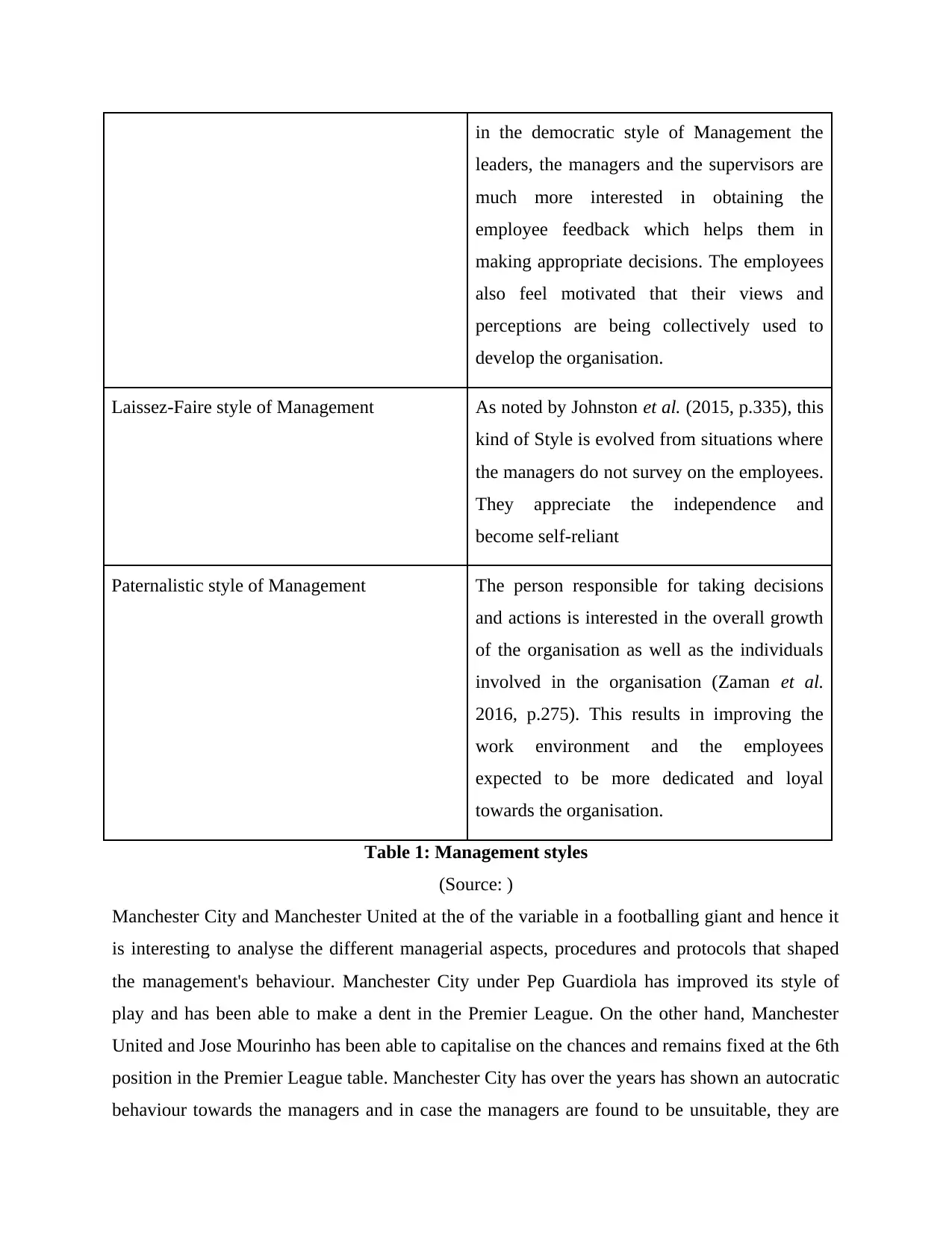
in the democratic style of Management the
leaders, the managers and the supervisors are
much more interested in obtaining the
employee feedback which helps them in
making appropriate decisions. The employees
also feel motivated that their views and
perceptions are being collectively used to
develop the organisation.
Laissez-Faire style of Management As noted by Johnston et al. (2015, p.335), this
kind of Style is evolved from situations where
the managers do not survey on the employees.
They appreciate the independence and
become self-reliant
Paternalistic style of Management The person responsible for taking decisions
and actions is interested in the overall growth
of the organisation as well as the individuals
involved in the organisation (Zaman et al.
2016, p.275). This results in improving the
work environment and the employees
expected to be more dedicated and loyal
towards the organisation.
Table 1: Management styles
(Source: )
Manchester City and Manchester United at the of the variable in a footballing giant and hence it
is interesting to analyse the different managerial aspects, procedures and protocols that shaped
the management's behaviour. Manchester City under Pep Guardiola has improved its style of
play and has been able to make a dent in the Premier League. On the other hand, Manchester
United and Jose Mourinho has been able to capitalise on the chances and remains fixed at the 6th
position in the Premier League table. Manchester City has over the years has shown an autocratic
behaviour towards the managers and in case the managers are found to be unsuitable, they are
leaders, the managers and the supervisors are
much more interested in obtaining the
employee feedback which helps them in
making appropriate decisions. The employees
also feel motivated that their views and
perceptions are being collectively used to
develop the organisation.
Laissez-Faire style of Management As noted by Johnston et al. (2015, p.335), this
kind of Style is evolved from situations where
the managers do not survey on the employees.
They appreciate the independence and
become self-reliant
Paternalistic style of Management The person responsible for taking decisions
and actions is interested in the overall growth
of the organisation as well as the individuals
involved in the organisation (Zaman et al.
2016, p.275). This results in improving the
work environment and the employees
expected to be more dedicated and loyal
towards the organisation.
Table 1: Management styles
(Source: )
Manchester City and Manchester United at the of the variable in a footballing giant and hence it
is interesting to analyse the different managerial aspects, procedures and protocols that shaped
the management's behaviour. Manchester City under Pep Guardiola has improved its style of
play and has been able to make a dent in the Premier League. On the other hand, Manchester
United and Jose Mourinho has been able to capitalise on the chances and remains fixed at the 6th
position in the Premier League table. Manchester City has over the years has shown an autocratic
behaviour towards the managers and in case the managers are found to be unsuitable, they are
Paraphrase This Document
Need a fresh take? Get an instant paraphrase of this document with our AI Paraphraser
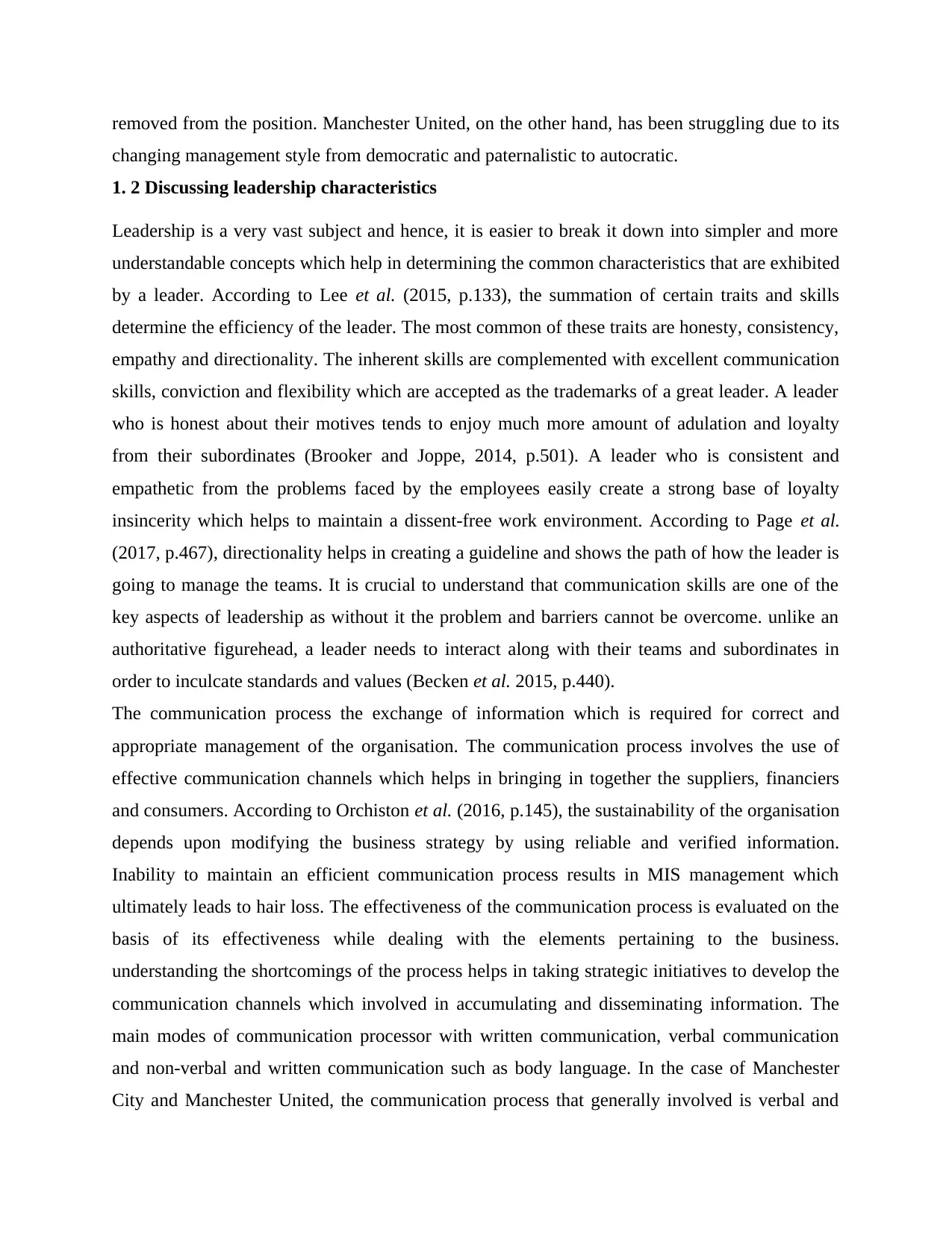
removed from the position. Manchester United, on the other hand, has been struggling due to its
changing management style from democratic and paternalistic to autocratic.
1. 2 Discussing leadership characteristics
Leadership is a very vast subject and hence, it is easier to break it down into simpler and more
understandable concepts which help in determining the common characteristics that are exhibited
by a leader. According to Lee et al. (2015, p.133), the summation of certain traits and skills
determine the efficiency of the leader. The most common of these traits are honesty, consistency,
empathy and directionality. The inherent skills are complemented with excellent communication
skills, conviction and flexibility which are accepted as the trademarks of a great leader. A leader
who is honest about their motives tends to enjoy much more amount of adulation and loyalty
from their subordinates (Brooker and Joppe, 2014, p.501). A leader who is consistent and
empathetic from the problems faced by the employees easily create a strong base of loyalty
insincerity which helps to maintain a dissent-free work environment. According to Page et al.
(2017, p.467), directionality helps in creating a guideline and shows the path of how the leader is
going to manage the teams. It is crucial to understand that communication skills are one of the
key aspects of leadership as without it the problem and barriers cannot be overcome. unlike an
authoritative figurehead, a leader needs to interact along with their teams and subordinates in
order to inculcate standards and values (Becken et al. 2015, p.440).
The communication process the exchange of information which is required for correct and
appropriate management of the organisation. The communication process involves the use of
effective communication channels which helps in bringing in together the suppliers, financiers
and consumers. According to Orchiston et al. (2016, p.145), the sustainability of the organisation
depends upon modifying the business strategy by using reliable and verified information.
Inability to maintain an efficient communication process results in MIS management which
ultimately leads to hair loss. The effectiveness of the communication process is evaluated on the
basis of its effectiveness while dealing with the elements pertaining to the business.
understanding the shortcomings of the process helps in taking strategic initiatives to develop the
communication channels which involved in accumulating and disseminating information. The
main modes of communication processor with written communication, verbal communication
and non-verbal and written communication such as body language. In the case of Manchester
City and Manchester United, the communication process that generally involved is verbal and
changing management style from democratic and paternalistic to autocratic.
1. 2 Discussing leadership characteristics
Leadership is a very vast subject and hence, it is easier to break it down into simpler and more
understandable concepts which help in determining the common characteristics that are exhibited
by a leader. According to Lee et al. (2015, p.133), the summation of certain traits and skills
determine the efficiency of the leader. The most common of these traits are honesty, consistency,
empathy and directionality. The inherent skills are complemented with excellent communication
skills, conviction and flexibility which are accepted as the trademarks of a great leader. A leader
who is honest about their motives tends to enjoy much more amount of adulation and loyalty
from their subordinates (Brooker and Joppe, 2014, p.501). A leader who is consistent and
empathetic from the problems faced by the employees easily create a strong base of loyalty
insincerity which helps to maintain a dissent-free work environment. According to Page et al.
(2017, p.467), directionality helps in creating a guideline and shows the path of how the leader is
going to manage the teams. It is crucial to understand that communication skills are one of the
key aspects of leadership as without it the problem and barriers cannot be overcome. unlike an
authoritative figurehead, a leader needs to interact along with their teams and subordinates in
order to inculcate standards and values (Becken et al. 2015, p.440).
The communication process the exchange of information which is required for correct and
appropriate management of the organisation. The communication process involves the use of
effective communication channels which helps in bringing in together the suppliers, financiers
and consumers. According to Orchiston et al. (2016, p.145), the sustainability of the organisation
depends upon modifying the business strategy by using reliable and verified information.
Inability to maintain an efficient communication process results in MIS management which
ultimately leads to hair loss. The effectiveness of the communication process is evaluated on the
basis of its effectiveness while dealing with the elements pertaining to the business.
understanding the shortcomings of the process helps in taking strategic initiatives to develop the
communication channels which involved in accumulating and disseminating information. The
main modes of communication processor with written communication, verbal communication
and non-verbal and written communication such as body language. In the case of Manchester
City and Manchester United, the communication process that generally involved is verbal and
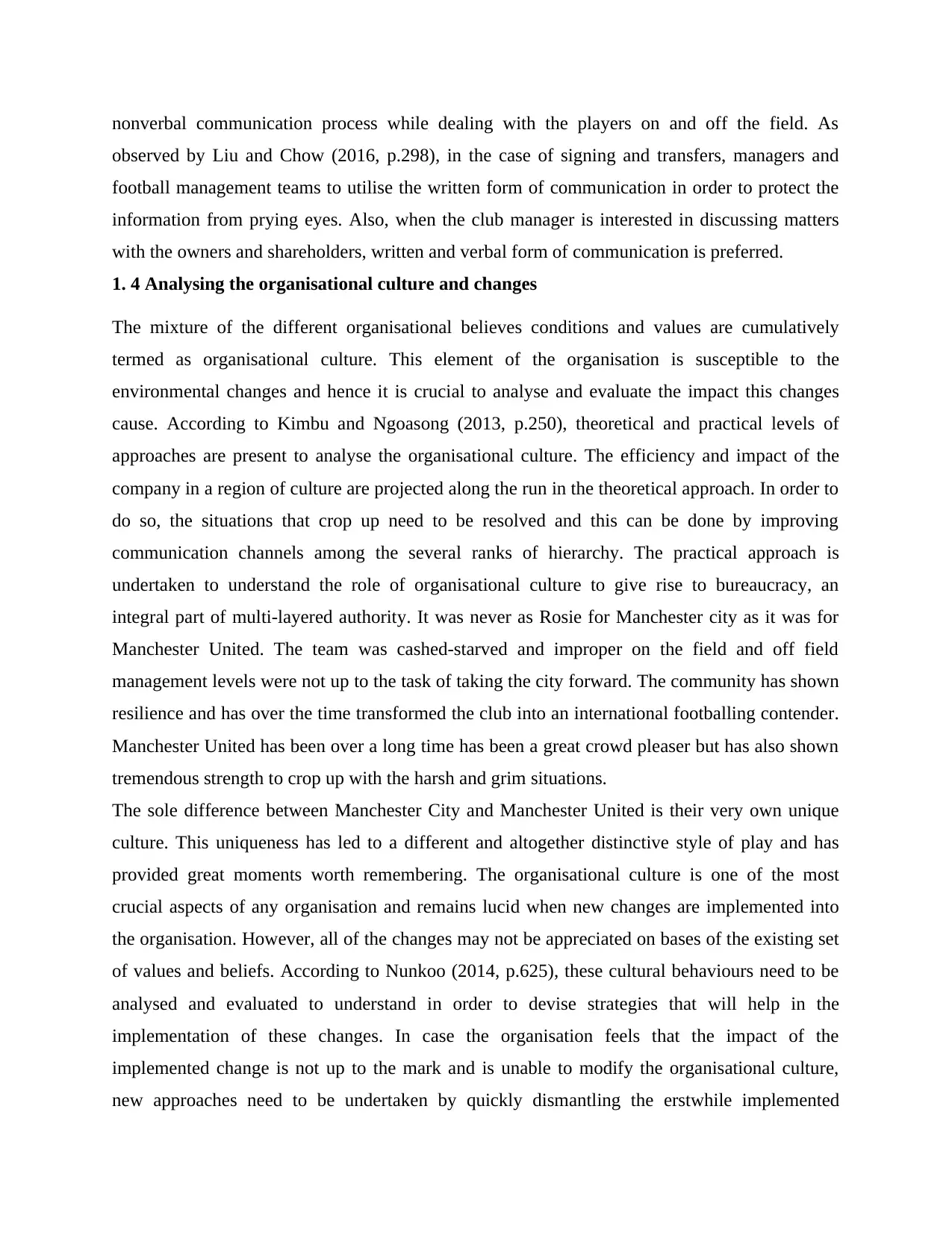
nonverbal communication process while dealing with the players on and off the field. As
observed by Liu and Chow (2016, p.298), in the case of signing and transfers, managers and
football management teams to utilise the written form of communication in order to protect the
information from prying eyes. Also, when the club manager is interested in discussing matters
with the owners and shareholders, written and verbal form of communication is preferred.
1. 4 Analysing the organisational culture and changes
The mixture of the different organisational believes conditions and values are cumulatively
termed as organisational culture. This element of the organisation is susceptible to the
environmental changes and hence it is crucial to analyse and evaluate the impact this changes
cause. According to Kimbu and Ngoasong (2013, p.250), theoretical and practical levels of
approaches are present to analyse the organisational culture. The efficiency and impact of the
company in a region of culture are projected along the run in the theoretical approach. In order to
do so, the situations that crop up need to be resolved and this can be done by improving
communication channels among the several ranks of hierarchy. The practical approach is
undertaken to understand the role of organisational culture to give rise to bureaucracy, an
integral part of multi-layered authority. It was never as Rosie for Manchester city as it was for
Manchester United. The team was cashed-starved and improper on the field and off field
management levels were not up to the task of taking the city forward. The community has shown
resilience and has over the time transformed the club into an international footballing contender.
Manchester United has been over a long time has been a great crowd pleaser but has also shown
tremendous strength to crop up with the harsh and grim situations.
The sole difference between Manchester City and Manchester United is their very own unique
culture. This uniqueness has led to a different and altogether distinctive style of play and has
provided great moments worth remembering. The organisational culture is one of the most
crucial aspects of any organisation and remains lucid when new changes are implemented into
the organisation. However, all of the changes may not be appreciated on bases of the existing set
of values and beliefs. According to Nunkoo (2014, p.625), these cultural behaviours need to be
analysed and evaluated to understand in order to devise strategies that will help in the
implementation of these changes. In case the organisation feels that the impact of the
implemented change is not up to the mark and is unable to modify the organisational culture,
new approaches need to be undertaken by quickly dismantling the erstwhile implemented
observed by Liu and Chow (2016, p.298), in the case of signing and transfers, managers and
football management teams to utilise the written form of communication in order to protect the
information from prying eyes. Also, when the club manager is interested in discussing matters
with the owners and shareholders, written and verbal form of communication is preferred.
1. 4 Analysing the organisational culture and changes
The mixture of the different organisational believes conditions and values are cumulatively
termed as organisational culture. This element of the organisation is susceptible to the
environmental changes and hence it is crucial to analyse and evaluate the impact this changes
cause. According to Kimbu and Ngoasong (2013, p.250), theoretical and practical levels of
approaches are present to analyse the organisational culture. The efficiency and impact of the
company in a region of culture are projected along the run in the theoretical approach. In order to
do so, the situations that crop up need to be resolved and this can be done by improving
communication channels among the several ranks of hierarchy. The practical approach is
undertaken to understand the role of organisational culture to give rise to bureaucracy, an
integral part of multi-layered authority. It was never as Rosie for Manchester city as it was for
Manchester United. The team was cashed-starved and improper on the field and off field
management levels were not up to the task of taking the city forward. The community has shown
resilience and has over the time transformed the club into an international footballing contender.
Manchester United has been over a long time has been a great crowd pleaser but has also shown
tremendous strength to crop up with the harsh and grim situations.
The sole difference between Manchester City and Manchester United is their very own unique
culture. This uniqueness has led to a different and altogether distinctive style of play and has
provided great moments worth remembering. The organisational culture is one of the most
crucial aspects of any organisation and remains lucid when new changes are implemented into
the organisation. However, all of the changes may not be appreciated on bases of the existing set
of values and beliefs. According to Nunkoo (2014, p.625), these cultural behaviours need to be
analysed and evaluated to understand in order to devise strategies that will help in the
implementation of these changes. In case the organisation feels that the impact of the
implemented change is not up to the mark and is unable to modify the organisational culture,
new approaches need to be undertaken by quickly dismantling the erstwhile implemented
⊘ This is a preview!⊘
Do you want full access?
Subscribe today to unlock all pages.

Trusted by 1+ million students worldwide
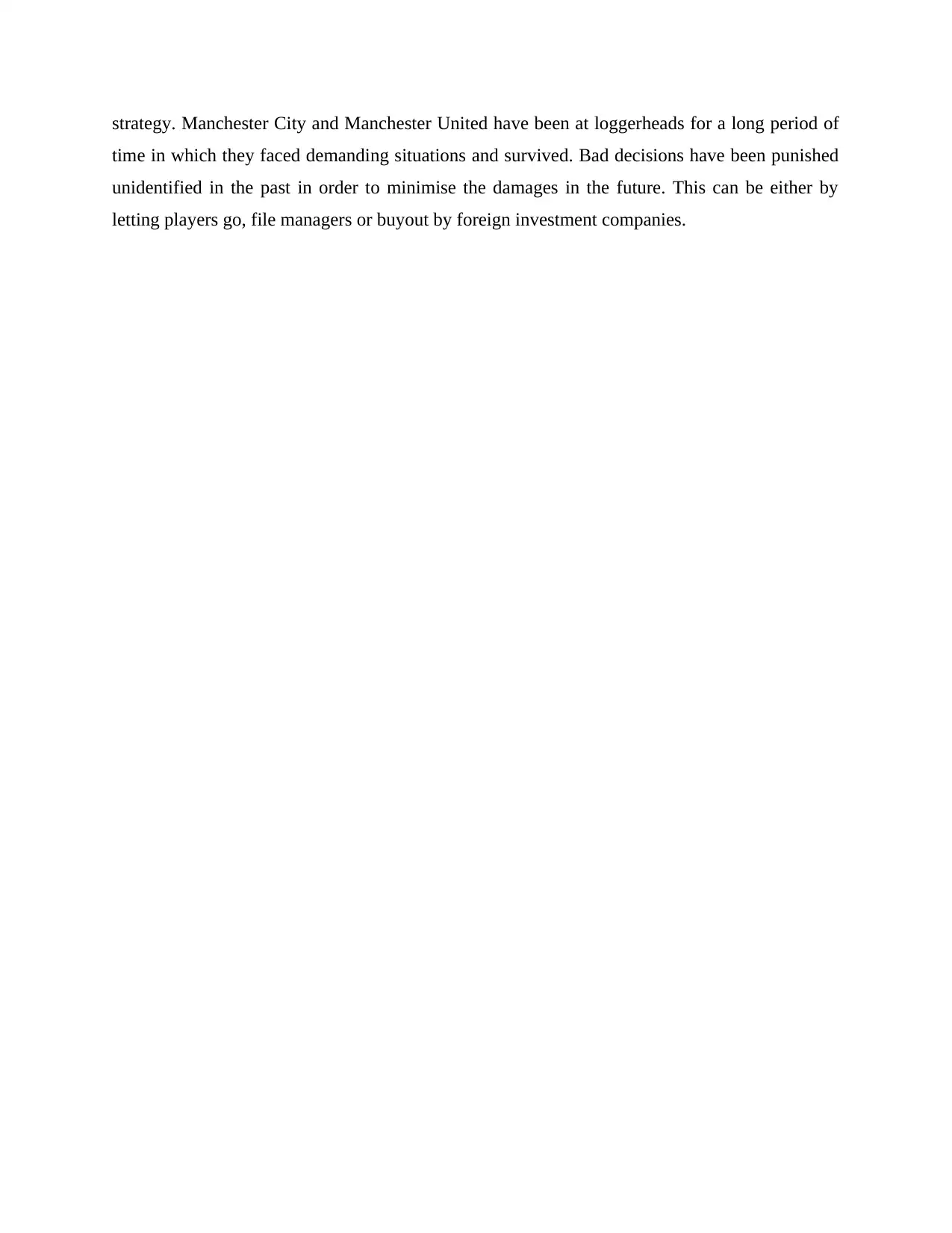
strategy. Manchester City and Manchester United have been at loggerheads for a long period of
time in which they faced demanding situations and survived. Bad decisions have been punished
unidentified in the past in order to minimise the damages in the future. This can be either by
letting players go, file managers or buyout by foreign investment companies.
time in which they faced demanding situations and survived. Bad decisions have been punished
unidentified in the past in order to minimise the damages in the future. This can be either by
letting players go, file managers or buyout by foreign investment companies.
Paraphrase This Document
Need a fresh take? Get an instant paraphrase of this document with our AI Paraphraser
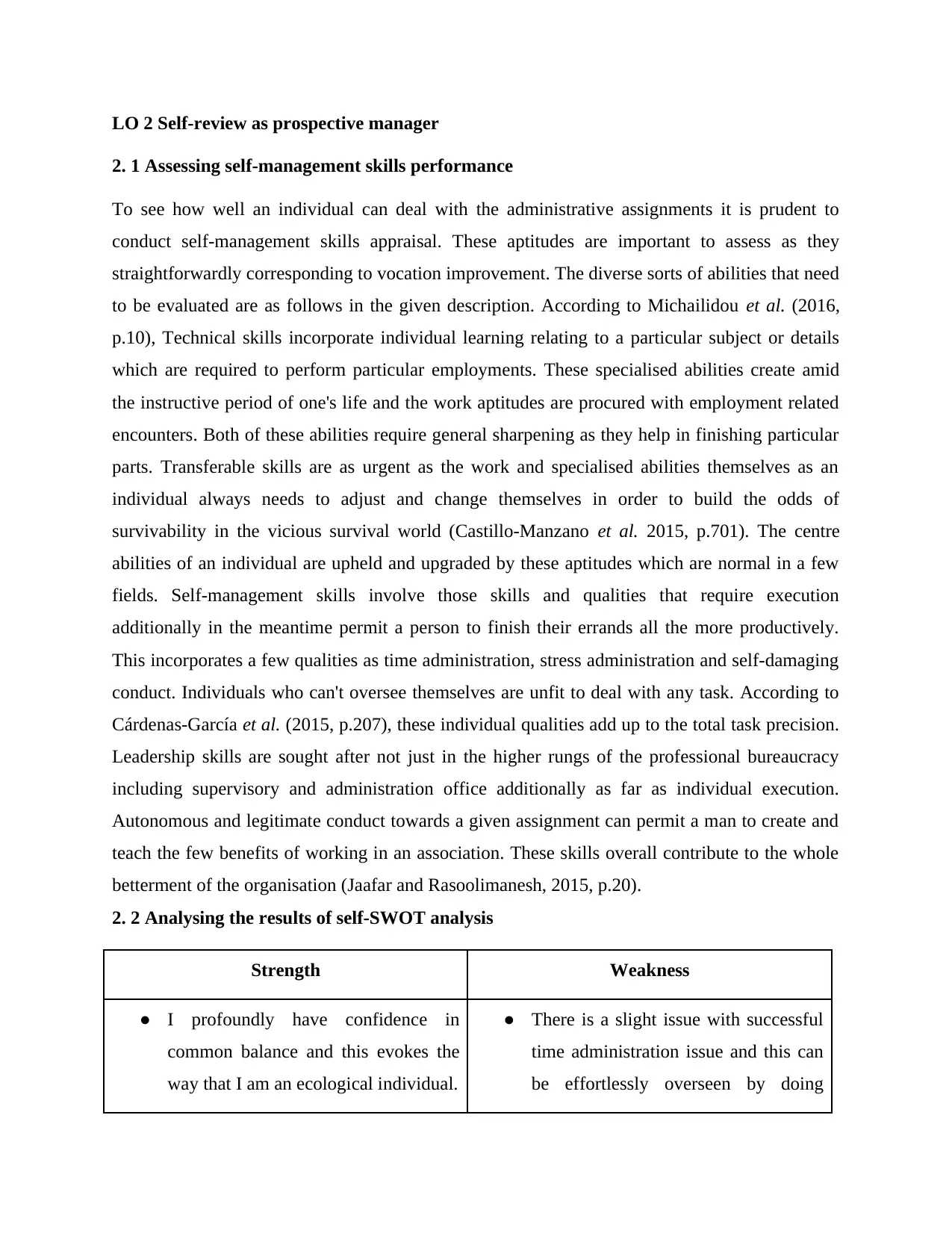
LO 2 Self-review as prospective manager
2. 1 Assessing self-management skills performance
To see how well an individual can deal with the administrative assignments it is prudent to
conduct self-management skills appraisal. These aptitudes are important to assess as they
straightforwardly corresponding to vocation improvement. The diverse sorts of abilities that need
to be evaluated are as follows in the given description. According to Michailidou et al. (2016,
p.10), Technical skills incorporate individual learning relating to a particular subject or details
which are required to perform particular employments. These specialised abilities create amid
the instructive period of one's life and the work aptitudes are procured with employment related
encounters. Both of these abilities require general sharpening as they help in finishing particular
parts. Transferable skills are as urgent as the work and specialised abilities themselves as an
individual always needs to adjust and change themselves in order to build the odds of
survivability in the vicious survival world (Castillo-Manzano et al. 2015, p.701). The centre
abilities of an individual are upheld and upgraded by these aptitudes which are normal in a few
fields. Self-management skills involve those skills and qualities that require execution
additionally in the meantime permit a person to finish their errands all the more productively.
This incorporates a few qualities as time administration, stress administration and self-damaging
conduct. Individuals who can't oversee themselves are unfit to deal with any task. According to
Cárdenas-García et al. (2015, p.207), these individual qualities add up to the total task precision.
Leadership skills are sought after not just in the higher rungs of the professional bureaucracy
including supervisory and administration office additionally as far as individual execution.
Autonomous and legitimate conduct towards a given assignment can permit a man to create and
teach the few benefits of working in an association. These skills overall contribute to the whole
betterment of the organisation (Jaafar and Rasoolimanesh, 2015, p.20).
2. 2 Analysing the results of self-SWOT analysis
Strength Weakness
● I profoundly have confidence in
common balance and this evokes the
way that I am an ecological individual.
● There is a slight issue with successful
time administration issue and this can
be effortlessly overseen by doing
2. 1 Assessing self-management skills performance
To see how well an individual can deal with the administrative assignments it is prudent to
conduct self-management skills appraisal. These aptitudes are important to assess as they
straightforwardly corresponding to vocation improvement. The diverse sorts of abilities that need
to be evaluated are as follows in the given description. According to Michailidou et al. (2016,
p.10), Technical skills incorporate individual learning relating to a particular subject or details
which are required to perform particular employments. These specialised abilities create amid
the instructive period of one's life and the work aptitudes are procured with employment related
encounters. Both of these abilities require general sharpening as they help in finishing particular
parts. Transferable skills are as urgent as the work and specialised abilities themselves as an
individual always needs to adjust and change themselves in order to build the odds of
survivability in the vicious survival world (Castillo-Manzano et al. 2015, p.701). The centre
abilities of an individual are upheld and upgraded by these aptitudes which are normal in a few
fields. Self-management skills involve those skills and qualities that require execution
additionally in the meantime permit a person to finish their errands all the more productively.
This incorporates a few qualities as time administration, stress administration and self-damaging
conduct. Individuals who can't oversee themselves are unfit to deal with any task. According to
Cárdenas-García et al. (2015, p.207), these individual qualities add up to the total task precision.
Leadership skills are sought after not just in the higher rungs of the professional bureaucracy
including supervisory and administration office additionally as far as individual execution.
Autonomous and legitimate conduct towards a given assignment can permit a man to create and
teach the few benefits of working in an association. These skills overall contribute to the whole
betterment of the organisation (Jaafar and Rasoolimanesh, 2015, p.20).
2. 2 Analysing the results of self-SWOT analysis
Strength Weakness
● I profoundly have confidence in
common balance and this evokes the
way that I am an ecological individual.
● There is a slight issue with successful
time administration issue and this can
be effortlessly overseen by doing
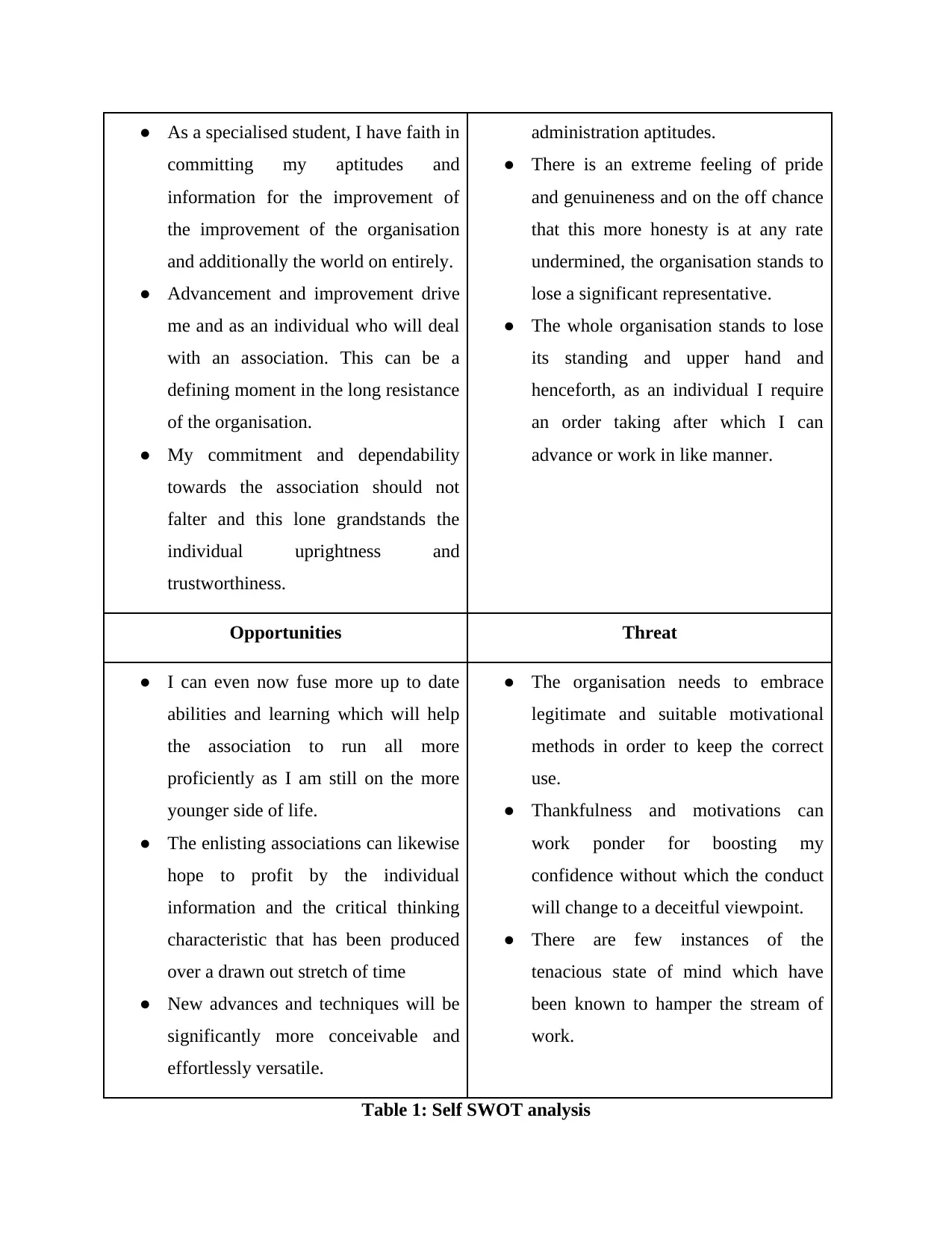
● As a specialised student, I have faith in
committing my aptitudes and
information for the improvement of
the improvement of the organisation
and additionally the world on entirely.
● Advancement and improvement drive
me and as an individual who will deal
with an association. This can be a
defining moment in the long resistance
of the organisation.
● My commitment and dependability
towards the association should not
falter and this lone grandstands the
individual uprightness and
trustworthiness.
administration aptitudes.
● There is an extreme feeling of pride
and genuineness and on the off chance
that this more honesty is at any rate
undermined, the organisation stands to
lose a significant representative.
● The whole organisation stands to lose
its standing and upper hand and
henceforth, as an individual I require
an order taking after which I can
advance or work in like manner.
Opportunities Threat
● I can even now fuse more up to date
abilities and learning which will help
the association to run all more
proficiently as I am still on the more
younger side of life.
● The enlisting associations can likewise
hope to profit by the individual
information and the critical thinking
characteristic that has been produced
over a drawn out stretch of time
● New advances and techniques will be
significantly more conceivable and
effortlessly versatile.
● The organisation needs to embrace
legitimate and suitable motivational
methods in order to keep the correct
use.
● Thankfulness and motivations can
work ponder for boosting my
confidence without which the conduct
will change to a deceitful viewpoint.
● There are few instances of the
tenacious state of mind which have
been known to hamper the stream of
work.
Table 1: Self SWOT analysis
committing my aptitudes and
information for the improvement of
the improvement of the organisation
and additionally the world on entirely.
● Advancement and improvement drive
me and as an individual who will deal
with an association. This can be a
defining moment in the long resistance
of the organisation.
● My commitment and dependability
towards the association should not
falter and this lone grandstands the
individual uprightness and
trustworthiness.
administration aptitudes.
● There is an extreme feeling of pride
and genuineness and on the off chance
that this more honesty is at any rate
undermined, the organisation stands to
lose a significant representative.
● The whole organisation stands to lose
its standing and upper hand and
henceforth, as an individual I require
an order taking after which I can
advance or work in like manner.
Opportunities Threat
● I can even now fuse more up to date
abilities and learning which will help
the association to run all more
proficiently as I am still on the more
younger side of life.
● The enlisting associations can likewise
hope to profit by the individual
information and the critical thinking
characteristic that has been produced
over a drawn out stretch of time
● New advances and techniques will be
significantly more conceivable and
effortlessly versatile.
● The organisation needs to embrace
legitimate and suitable motivational
methods in order to keep the correct
use.
● Thankfulness and motivations can
work ponder for boosting my
confidence without which the conduct
will change to a deceitful viewpoint.
● There are few instances of the
tenacious state of mind which have
been known to hamper the stream of
work.
Table 1: Self SWOT analysis
⊘ This is a preview!⊘
Do you want full access?
Subscribe today to unlock all pages.

Trusted by 1+ million students worldwide
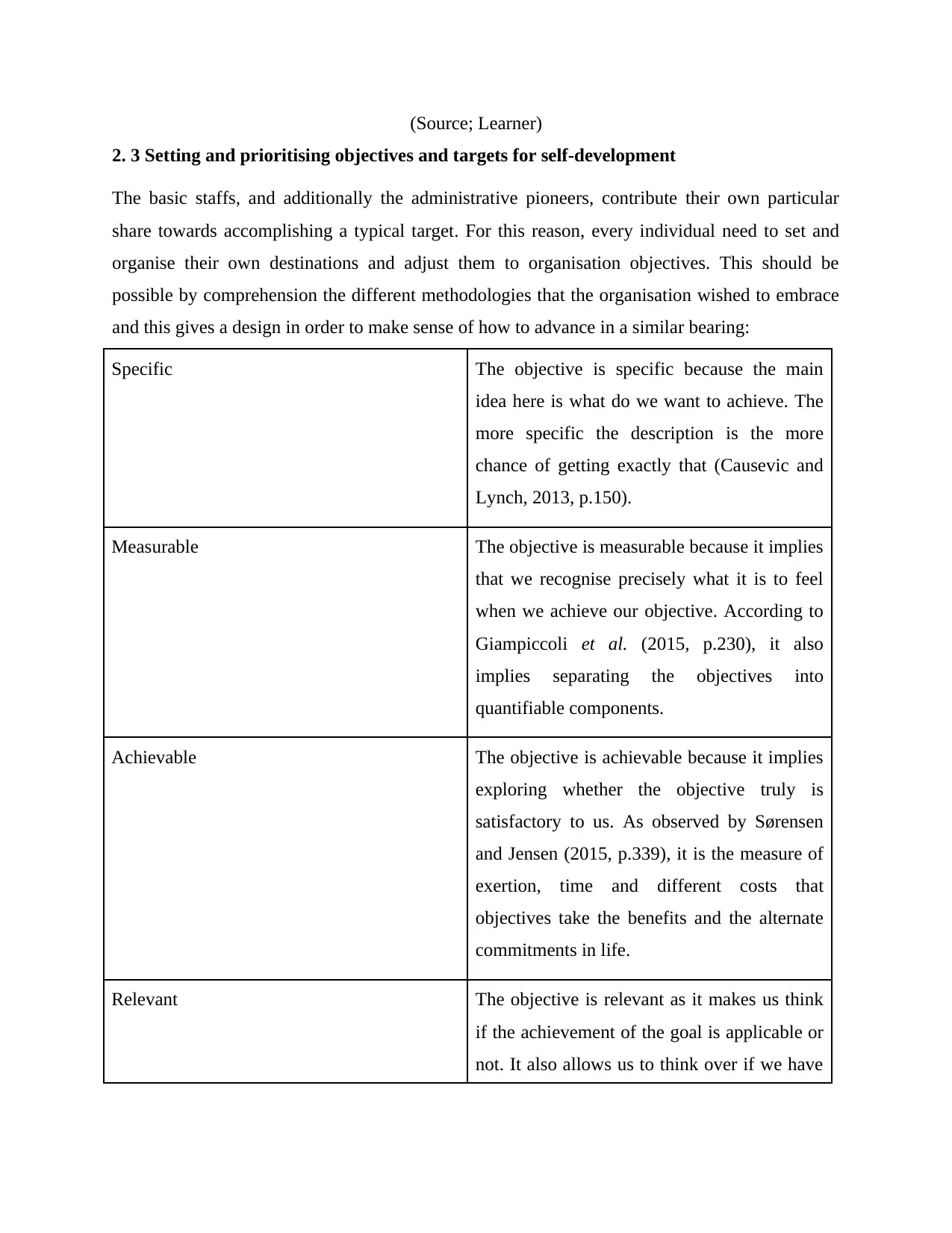
(Source; Learner)
2. 3 Setting and prioritising objectives and targets for self-development
The basic staffs, and additionally the administrative pioneers, contribute their own particular
share towards accomplishing a typical target. For this reason, every individual need to set and
organise their own destinations and adjust them to organisation objectives. This should be
possible by comprehension the different methodologies that the organisation wished to embrace
and this gives a design in order to make sense of how to advance in a similar bearing:
Specific The objective is specific because the main
idea here is what do we want to achieve. The
more specific the description is the more
chance of getting exactly that (Causevic and
Lynch, 2013, p.150).
Measurable The objective is measurable because it implies
that we recognise precisely what it is to feel
when we achieve our objective. According to
Giampiccoli et al. (2015, p.230), it also
implies separating the objectives into
quantifiable components.
Achievable The objective is achievable because it implies
exploring whether the objective truly is
satisfactory to us. As observed by Sørensen
and Jensen (2015, p.339), it is the measure of
exertion, time and different costs that
objectives take the benefits and the alternate
commitments in life.
Relevant The objective is relevant as it makes us think
if the achievement of the goal is applicable or
not. It also allows us to think over if we have
2. 3 Setting and prioritising objectives and targets for self-development
The basic staffs, and additionally the administrative pioneers, contribute their own particular
share towards accomplishing a typical target. For this reason, every individual need to set and
organise their own destinations and adjust them to organisation objectives. This should be
possible by comprehension the different methodologies that the organisation wished to embrace
and this gives a design in order to make sense of how to advance in a similar bearing:
Specific The objective is specific because the main
idea here is what do we want to achieve. The
more specific the description is the more
chance of getting exactly that (Causevic and
Lynch, 2013, p.150).
Measurable The objective is measurable because it implies
that we recognise precisely what it is to feel
when we achieve our objective. According to
Giampiccoli et al. (2015, p.230), it also
implies separating the objectives into
quantifiable components.
Achievable The objective is achievable because it implies
exploring whether the objective truly is
satisfactory to us. As observed by Sørensen
and Jensen (2015, p.339), it is the measure of
exertion, time and different costs that
objectives take the benefits and the alternate
commitments in life.
Relevant The objective is relevant as it makes us think
if the achievement of the goal is applicable or
not. It also allows us to think over if we have
Paraphrase This Document
Need a fresh take? Get an instant paraphrase of this document with our AI Paraphraser
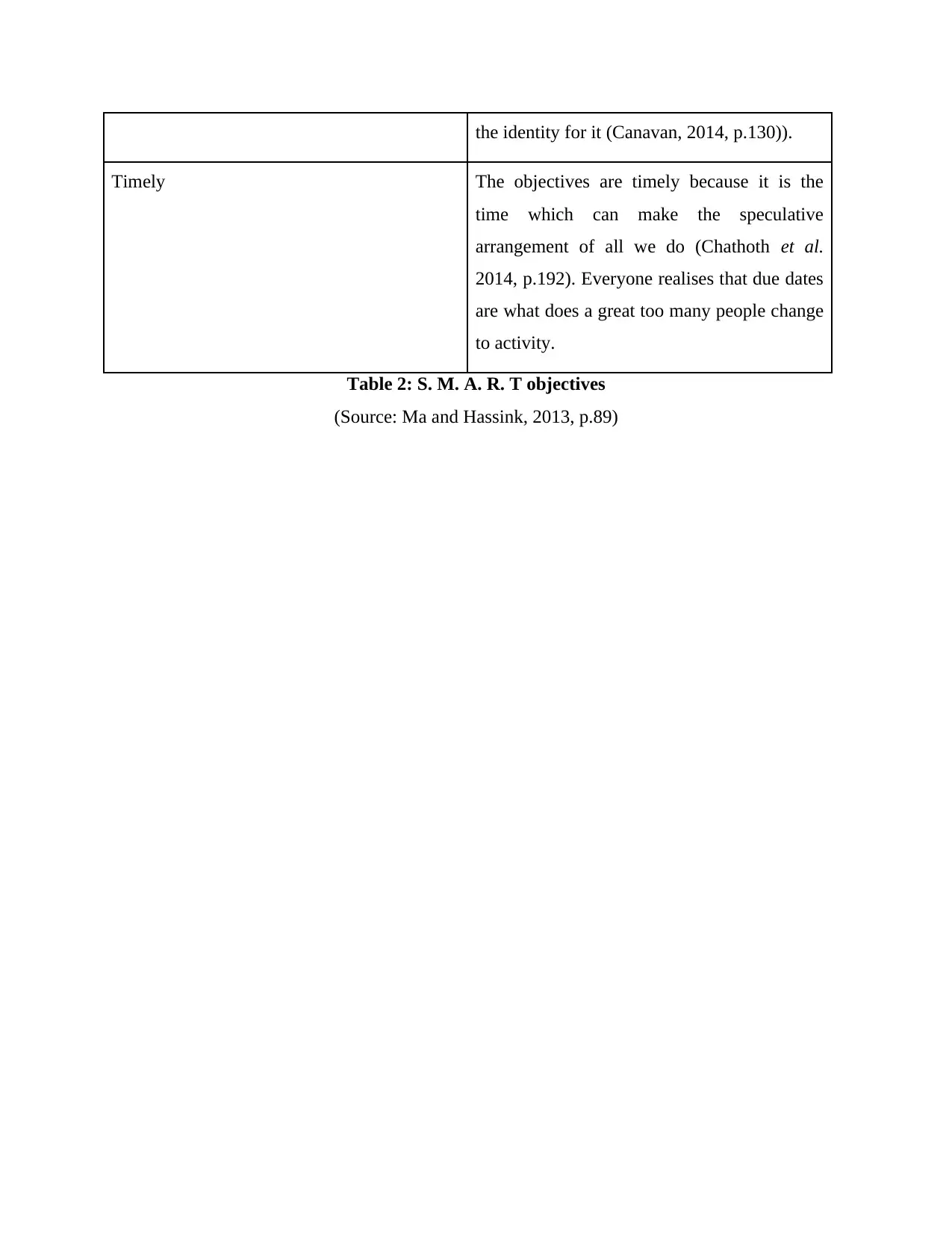
the identity for it (Canavan, 2014, p.130)).
Timely The objectives are timely because it is the
time which can make the speculative
arrangement of all we do (Chathoth et al.
2014, p.192). Everyone realises that due dates
are what does a great too many people change
to activity.
Table 2: S. M. A. R. T objectives
(Source: Ma and Hassink, 2013, p.89)
Timely The objectives are timely because it is the
time which can make the speculative
arrangement of all we do (Chathoth et al.
2014, p.192). Everyone realises that due dates
are what does a great too many people change
to activity.
Table 2: S. M. A. R. T objectives
(Source: Ma and Hassink, 2013, p.89)
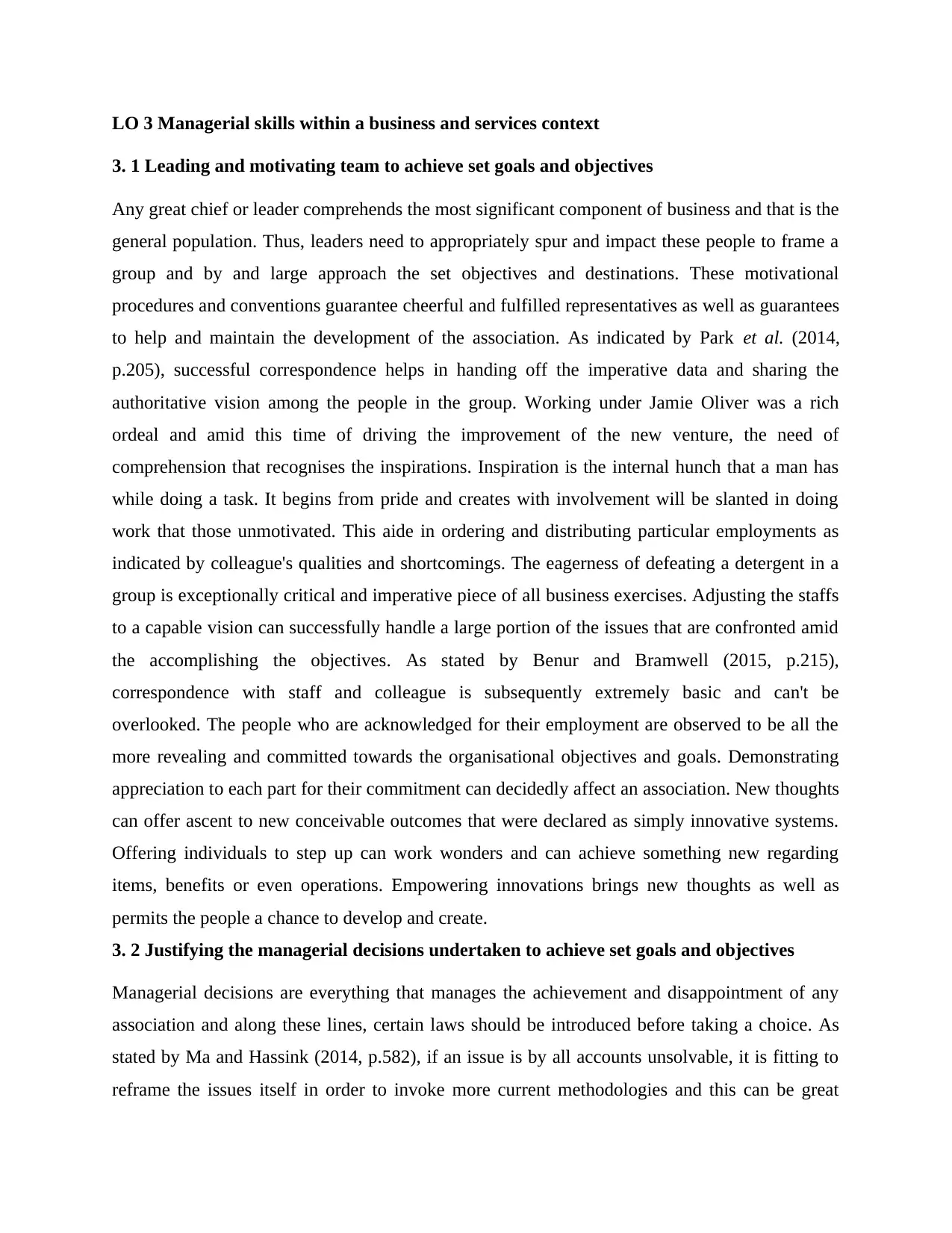
LO 3 Managerial skills within a business and services context
3. 1 Leading and motivating team to achieve set goals and objectives
Any great chief or leader comprehends the most significant component of business and that is the
general population. Thus, leaders need to appropriately spur and impact these people to frame a
group and by and large approach the set objectives and destinations. These motivational
procedures and conventions guarantee cheerful and fulfilled representatives as well as guarantees
to help and maintain the development of the association. As indicated by Park et al. (2014,
p.205), successful correspondence helps in handing off the imperative data and sharing the
authoritative vision among the people in the group. Working under Jamie Oliver was a rich
ordeal and amid this time of driving the improvement of the new venture, the need of
comprehension that recognises the inspirations. Inspiration is the internal hunch that a man has
while doing a task. It begins from pride and creates with involvement will be slanted in doing
work that those unmotivated. This aide in ordering and distributing particular employments as
indicated by colleague's qualities and shortcomings. The eagerness of defeating a detergent in a
group is exceptionally critical and imperative piece of all business exercises. Adjusting the staffs
to a capable vision can successfully handle a large portion of the issues that are confronted amid
the accomplishing the objectives. As stated by Benur and Bramwell (2015, p.215),
correspondence with staff and colleague is subsequently extremely basic and can't be
overlooked. The people who are acknowledged for their employment are observed to be all the
more revealing and committed towards the organisational objectives and goals. Demonstrating
appreciation to each part for their commitment can decidedly affect an association. New thoughts
can offer ascent to new conceivable outcomes that were declared as simply innovative systems.
Offering individuals to step up can work wonders and can achieve something new regarding
items, benefits or even operations. Empowering innovations brings new thoughts as well as
permits the people a chance to develop and create.
3. 2 Justifying the managerial decisions undertaken to achieve set goals and objectives
Managerial decisions are everything that manages the achievement and disappointment of any
association and along these lines, certain laws should be introduced before taking a choice. As
stated by Ma and Hassink (2014, p.582), if an issue is by all accounts unsolvable, it is fitting to
reframe the issues itself in order to invoke more current methodologies and this can be great
3. 1 Leading and motivating team to achieve set goals and objectives
Any great chief or leader comprehends the most significant component of business and that is the
general population. Thus, leaders need to appropriately spur and impact these people to frame a
group and by and large approach the set objectives and destinations. These motivational
procedures and conventions guarantee cheerful and fulfilled representatives as well as guarantees
to help and maintain the development of the association. As indicated by Park et al. (2014,
p.205), successful correspondence helps in handing off the imperative data and sharing the
authoritative vision among the people in the group. Working under Jamie Oliver was a rich
ordeal and amid this time of driving the improvement of the new venture, the need of
comprehension that recognises the inspirations. Inspiration is the internal hunch that a man has
while doing a task. It begins from pride and creates with involvement will be slanted in doing
work that those unmotivated. This aide in ordering and distributing particular employments as
indicated by colleague's qualities and shortcomings. The eagerness of defeating a detergent in a
group is exceptionally critical and imperative piece of all business exercises. Adjusting the staffs
to a capable vision can successfully handle a large portion of the issues that are confronted amid
the accomplishing the objectives. As stated by Benur and Bramwell (2015, p.215),
correspondence with staff and colleague is subsequently extremely basic and can't be
overlooked. The people who are acknowledged for their employment are observed to be all the
more revealing and committed towards the organisational objectives and goals. Demonstrating
appreciation to each part for their commitment can decidedly affect an association. New thoughts
can offer ascent to new conceivable outcomes that were declared as simply innovative systems.
Offering individuals to step up can work wonders and can achieve something new regarding
items, benefits or even operations. Empowering innovations brings new thoughts as well as
permits the people a chance to develop and create.
3. 2 Justifying the managerial decisions undertaken to achieve set goals and objectives
Managerial decisions are everything that manages the achievement and disappointment of any
association and along these lines, certain laws should be introduced before taking a choice. As
stated by Ma and Hassink (2014, p.582), if an issue is by all accounts unsolvable, it is fitting to
reframe the issues itself in order to invoke more current methodologies and this can be great
⊘ This is a preview!⊘
Do you want full access?
Subscribe today to unlock all pages.

Trusted by 1+ million students worldwide
1 out of 19
Related Documents
Your All-in-One AI-Powered Toolkit for Academic Success.
+13062052269
info@desklib.com
Available 24*7 on WhatsApp / Email
![[object Object]](/_next/static/media/star-bottom.7253800d.svg)
Unlock your academic potential
Copyright © 2020–2025 A2Z Services. All Rights Reserved. Developed and managed by ZUCOL.



